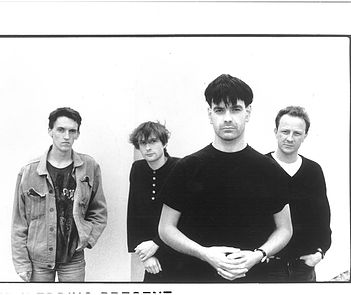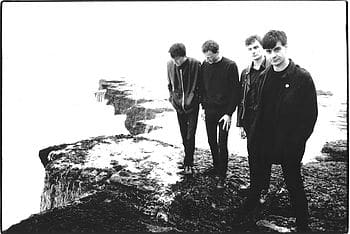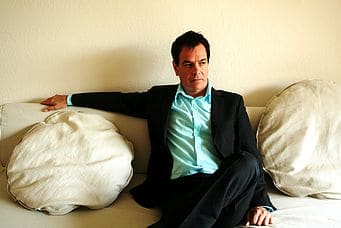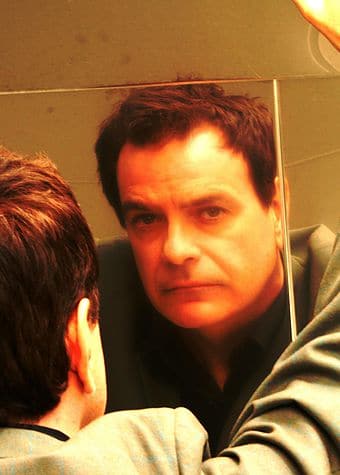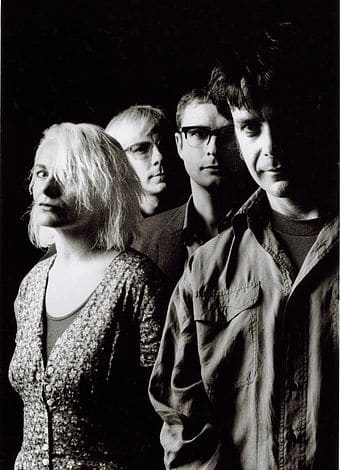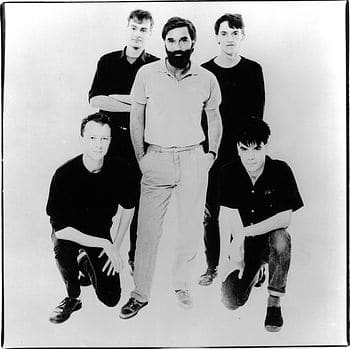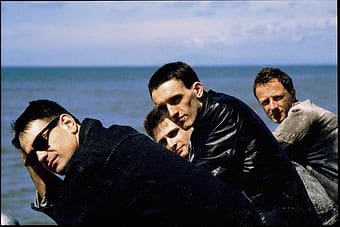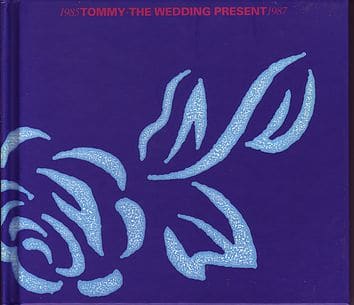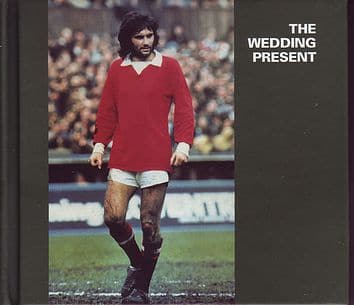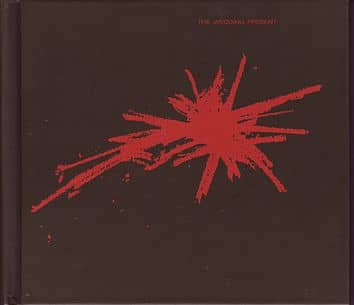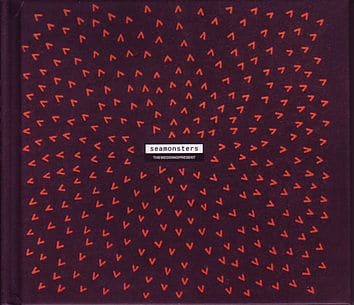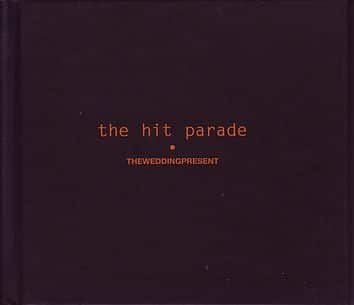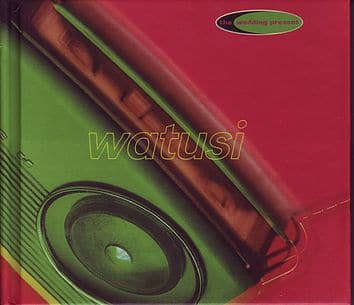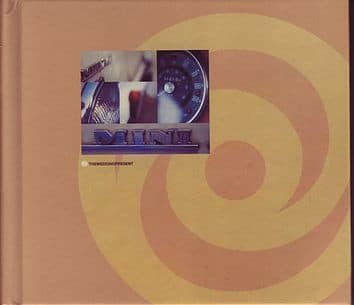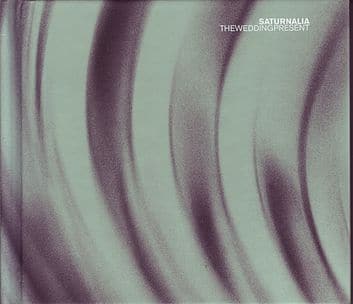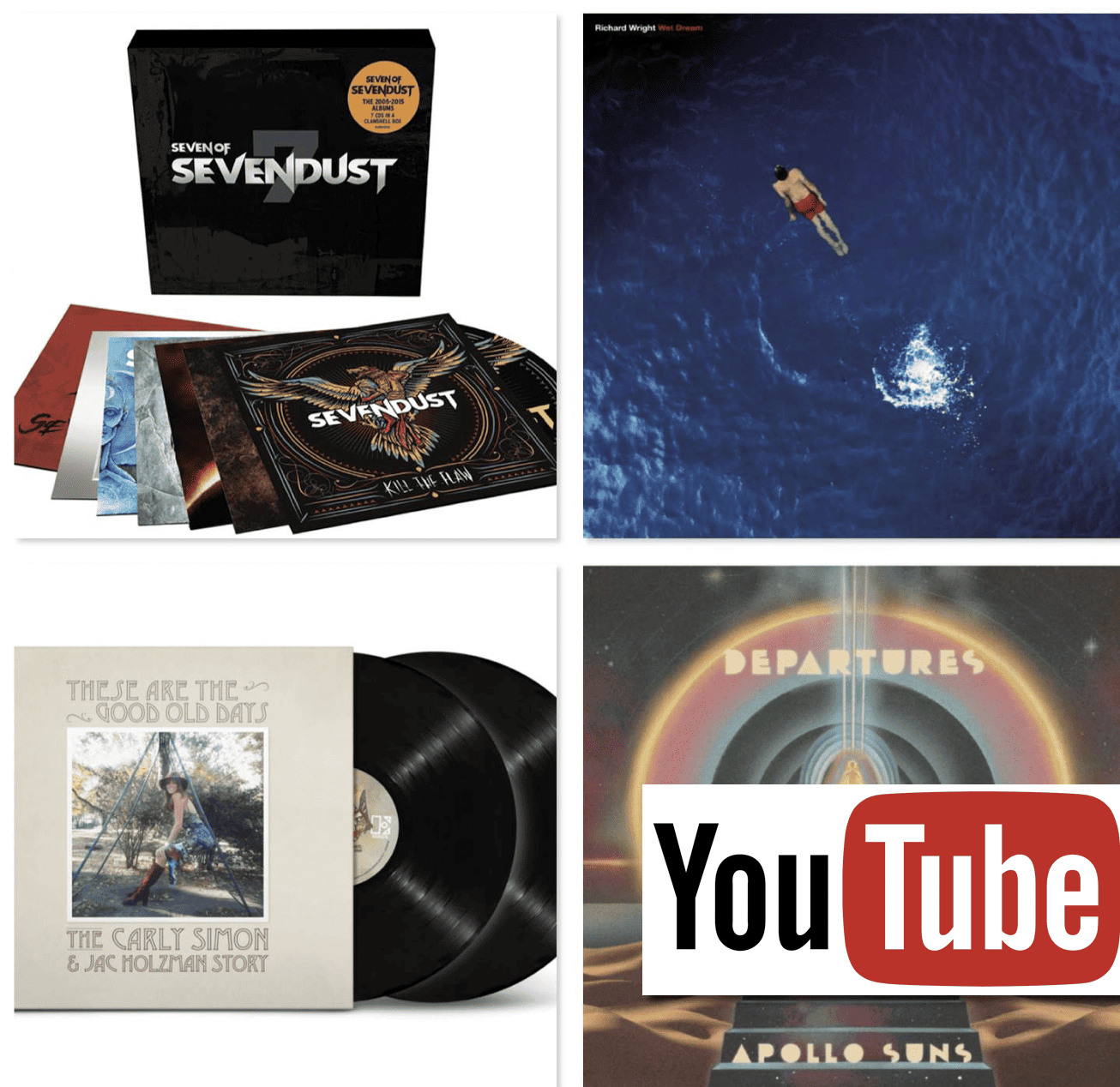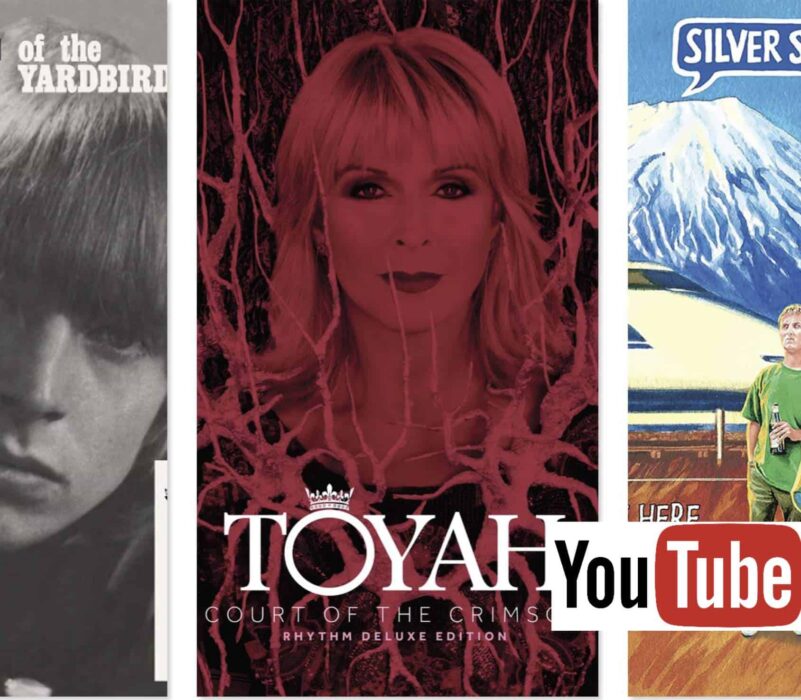The Article
What? Another Toaster? Talking to the Wedding Present
23rd October 2015
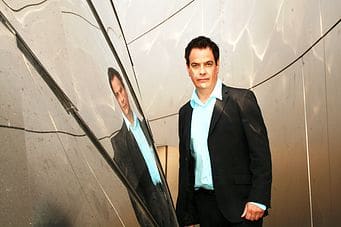
The recipient of a new reissue campaign, Paul Rigby talks to The Wedding Present’s lead singer and songwriter, David Gedge
“I’ve been working on a comic,” said a rather proud Gedge. “It’s called Tales From The Wedding Present. It’s going to be my biography but in comic book form. I write stories with my former bass player, Terry DeCastro. She joined the band when we started doing Cinerama, in 1997 and she was in the band until recently. During this time she had the idea of writing my biography. Based on the idea of her joining the band, what happened when she was there, then broadened it, interviewed my parents and people I’d worked with. It was never completed. She was too busy. There was a draft and there was still work to be done on it. Then she left the band anyway. It never carried on to a completion, which was a shame.”
Gedge has a deep, abiding love for the comic form which was probably why the biography turned graphic.
“Between Terry and I, we modified what she had been doing and sent the ideas to artist, Lee Thacker. We have done six issues now. We both got into it and now see it as a collection.”
At the moment, the comics spin tales of events that occurred when Terry was still in the band, over a period of 14-15 years. Gedge is considering taking the story back to the beginning, forming a more traditional biography timeline.
Appearing three times per year, the creation is Marvel comic-sized. It’s a part-time project for all concerned and you can buy the comics at the band’s concerts or via the website.
Before we left the comic theme, Gedge adopted an added frisson. A sort of complex mixture of pride, embarrassment and the sounds of a fulfilled private ambition as Gedge concluded with, “I live in Brighton now. I remember going down to my local comic shop. I asked the guy, ‘Would you be interested in stocking this?’ offering my comic to him. He didn’t know who I was or anything. And he accepted. So it’s actually in my comic shop!”
Gedge couldn’t, as the saying goes, smile wide enough.
Gedge’s family background is not exactly a musical one. He was the only family member to play an instrument or, for that matter, show any interest in picking one up, “There was always music in the house, though. Lots of rock’n’roll records. My dad was a big country music fan. My mum was into people like the Carpenters and Tom Jones. I went through that thing, pretending to be my own DJ with my own radio show. I’ve always been a big fan of radio. That was an important part of my childhood. Radio 1 and Radio Luxembourg, under the covers of my bed.”
Using his parent’s records as an immediate inspiration, 13 year old Gedge sauntered though The Beatles, Buddy Holly and Bill Haley. Then glam rock hit and so did Sweet, Mud and Slade, “…am I allowed to also say Gary Glitter?”
Gedge’s independence blossomed as he moved from his first LP purchase, Cockney Rebel’s The Psychomodo and then a movement into the prog rock of Genesis, Yes and Pink Floyd. Then punk arrived.
“I thought, ‘This is brilliant!’ I still love those bands. It became more exciting when it appeared to be four people who’ve just picked up guitars and played rock’n’roll. It seemed very simple and direct. It was inspiring. It was a massive change in music. It was a case of, if they can do it, we can do it. Looking at the likes of Rick Wakeman perform…it was a different world. Watching The Clash and The Sex Pistols perform I thought, ‘I know people like this.’”
This is when Gedge began listening to John Peel’s radio programme and indulging in the 7” single, expanding into a large collection in a short time, “Singles were the thing: Sex Pistols, Clash, Buzzcocks, Magazine. It wasn’t until later that I started honing into particular bands. It was a general scene. I’d be 16-17 at the time.”
Plans of forming a band where in Gedge’s thoughts already. In fact, University was a back-up plan in case his musical ambitions didn’t succeed. In the front of his head was a music-based existence. Whether that be as a DJ, a writer on music or similar. Singing was not really a priority. Now, song-writing. Well, that was different. That creative force. To create a song from nothing. That was and is part of the central part of the Gedge personality, “I’ve always been quite a driven person,” he said. “It was more of a case of me starting bands and bringing people in rather than me being invited into other groups. I was always the one to organise it. I think I was on my own in that way. I don’t remember too many people who shared my obsession. I’ve only really met those people subsequently, in bands and other professions where a similar ambition and drive is required. I do recognise those traits in other people. I see them and think ‘Yea, that’s what I was like.’”
Being driven and being a band leader are not always the same thing. At least, the role doesn’t always follow the inner urge.
“It’s more a case that, well, I’ve got these ideas that I’m working on, I’ve got a mate who plays guitar, he knows someone who pays bass. You enter a circle, a sort of gang who enjoy the same kind of thing. It’s only later on when the roles become solidified that the hierarchy sets in.”
The Wedding Present was not Gedge’s first band foray. There were plenty of “half joke” outfits created in University, “When I finally finished my degree, I was singing in The Lost Pandas. That was the first band that I thought we should do something serious with it, make a record, play proper concerts and set up on the road to stardom. It didn’t actually work out like that. That band only existed for a couple of years and then The Wedding Present started.”
Other bands that may have ‘got away’ are all, according to Gedge, “safely buried”. He remains grateful for his time in these bands and the Lost Pandas, as they provided him with an apprenticeship of sorts. He’s even grateful that the Lost Pandas never actually got around to creating a single, “I didn’t think they were good enough,” he said. Intriguingly, Gedge does have unpublished Lost Pandas material on master tape. So would he ever release these tracks as apart of a rarities package? “No. I do toy with the idea of releasing some of the songs as a rarities thing. Maybe, at some point, I’ll dig out all of those master tapes and listen to them.”
The Wedding Present itself began via a car accident. It involved the Lost Pandas’ guitarist, “He wasn’t seriously injured but he was due for a big pay out from the insurance company. He was a graphic artist and had to take time off work. We’d had an agreement that, when this money came, we would do a single. When the money did arrive, half of the band, him and his girlfriend, decided that they would take the money and go and live in New York.”
It was, as I’m sure that you can appreciate, a bit of a disappointment. That’s how the Lost Pandas ended. Gedge and the Lost Pandas bass player, Keith Gregory, began again with the help from Peter Solowka, a friend from school. And so The Wedding Present began. The last to join, Shaun Charman, answered an advert in the Students Union. Money was then saved for the band’s first single.
Gedge is the only surviving member of The Wedding Present which has become almost a forum for an ever going list of ex-band members. It’s almost as if Gedge isThe Wedding Present. Because there has been so many line-up changes, you begin to wonder if being a member of the band a stressful experience, “I don’t feel that I am The Wedding Present at all. I was the sole original member way back in 1994. It was quite soon. I’ve been adamant that the Wedding Present is whoever is in the band at the time. I’m not dictatorial about how the band should sound or how the songs are written. I’ve always been open to contributions from other members. This is why you can play different albums from our catalogue and they sound like different groups. I almost feel that I’ve been in different bands over the years because it’s changed so much.
“In some ways it would have been great to have been someone like U2 with the same four people who started the band and here we are 30 years later but it just didn’t work out. When people start a band, it sounds great. You’re writing songs for a living, travelling the world, making records, on the radio, meeting girls… It’s not as easy as it sounds. It loses the gloss over time. You begin to think, ‘Hmmm, I’m losing my girlfriend/boyfriend, my social network is breaking down at home because I’m away for half the year, the money is not as great as I thought it’d be…’ Terri, for instance, who was in the band for all those years, enjoyed it for a time then found it time to move on. Generally, it is an odd lifestyle. It’s different for me because I’m obsessed with it. I don’t see the hardships and it’s difficult for me to see through their eyes sometimes. There’s people who’ve we’ve asked to leave but, by and large, there are people who would leave anyway.”
There’s various reasons why anyone would want to leave a band or, in this case, The Wedding Present. Gedge admits that the whole process is upsetting. After all, to that point, in general terms, a band exists as a close-knit community, “You’re in the van, you’re on stage, you’re in the hotel and you’re in the studio,” said Gedge. “You’ve really got to get on. If anyone’s disillusioned with being in the group, they are suddenly less likely to make the compromise to carry on and they become more difficult and more argumentative. In Year 1 they would have put themselves out because they were really enjoying themselves. That’s the fundamental thing. You’ve got to co-operate and people are less likely to do that if they are not interested anymore.”
But we are getting ahead of ourselves somewhat. When the band first formed they, like all bands sought a break though. It occurred to The Wedding Present through one man: John Peel, “We had been rehearsing, recording demos and then we sent our first single to him. In fact, I travelled down to London and gave him a copy. He played it on the radio about 10 times. That was the transitional point. No longer was it us nipping into the pub and pleading, ‘Can we play in your back room?’ It was people coming to us and saying, ‘Heard your record on John Peel, come play in our venue.’ We were getting approached by music papers too. That was a huge shift in what we were.
“John knew who I was, I was trying to give him tapes on a regular basis – he received a Lost Pandas demo, at one point. I remember approaching him in Ilkley once, at the John Peel Roadshow.”
The first John Peel Session didn’t happen until later. The Session experience was a sought-after commodity but Peel hung back for a while. Gedge wondered, specifically, if that was down to he and Peel ‘knowing’ each other. It was if Peel was showing the world that, ‘Look, anyone can get a Session if they’re good enough. I’m not political and you don’t have to be a friend to gain entrance.’ Of course, that worked the other way, too. ‘Friends sometimes lost out. So The Wedding Present had to wait. In fact, the band’s first BBC Radio 1 session was via Peel’s fellow DJ, Andy Kershaw’s programme.
It was during the early period of the band that The Smiths were coming to the end of their life as a band. The Wedding Present were tagged, by the music press, as ‘The New Smiths’. Gedge wasn’t really aware of the attention at the time, “You are more focused on what you’re doing at the time. I think it was more a case of them, the media, looking for something to replace The Smiths. We had the same kind of background and possibly the same kind of fans. I did like The Smiths, one of the my favourite groups at the time but I don’t think we had much in common with them. I think I said, at the time, that I thought we were The Smiths fan’s second favourite group.”
The Wedding Present’s first album was the remarkable George Best. Gedge was a Manchester United fan at the time, “I grew up in Manchester and then went to Leeds University,” he said. “I remember Best as the star player. I was attracted to his image. The talent, yes, but also the fact that he missed practices because he was out the night before with Miss World and The Beatles in some night club, the beard, long hair, the first player to have his shirt out of his shorts. He had that cocky, rebellious air about him. Fantastic to a young lad in Manchester. The album itself was called that because it sounded good and I loved that photograph on the front cover. We looked through a sports photography archive to find it. Me and Keith saw it, looked at each other and said, ‘Wow!’ It was such an iconic image.”
Of course, this was the album that most Wedding Present fans got to hear their new heart-throbs and, of course, that they got to hear that unique Gedge vocal delivery, “I’d be the first to admit that I’m not the greatest singer in the world. There are certain people who open their mouths and suddenly flowers appear. I’ve definitely not got that. If I’ve got anything then it’s an honest delivery. It goes with the way I write the lyrics, very conversational and down to earth. There’s very little in the way of metaphor. It’s usually little stories told in everyday language. I think that I’ve improved as a singer, I tend to cringe at my earlier performance but I also think there is passion there. I’ve always been of the mind that there has to be angst in the lyrics with passion and anger.
Gedge has admitted that George Best (and Take Fountain for that matter) were the most personal albums he wrote. Both drew their content from real life stories, “Relationships can be so complicated that you can draw inspiration from them for years to come,” he confirmed. “There is an element of acting in my songs. They are all about me but not necessarily exactly things that have happened to me. So a song might be me inhabiting a character in the same way that an actor does. More of a ‘How would I act in that situation?’ I think the starting point is about myself and then it often goes off. It depends on the subject of the lyric, I think.”
Anyone who has been around the band as a fan for any length of time will realise that the group has its own record label, Scopitones. Created, not so much to protect band interest but because no one else was interested at the time, “We approached many esteemed labels such as 4AD, Rough Trade, Factory and everyone either ignored us or sent a rejection letter. By 1984, we decided not to bother but do it ourselves and pay for it ourselves. After that, because John Peel played that first single, it sold out, we signed up with Red Rhino a distribution company. So, we had a label but it was funded by Red Rhino. After that, the record labels did come to us. We quite enjoyed having our own label, though. We signed a couple of other bands to it too.”
During those early years, the media expected great things from the Wedding Present. Maybe things that the band itself were to find unacceptable. Gedge, for example, was supposed to conquer the US market but, let’s say that his stubborn nature precluded requests from music producers that ran against the grain, “I’m not going to deny that!,” said Gedge. “There’s definitely an element of that. People have said that we could have been more successful in Britain as well as the USA. I’m happy with what I’ve achieved. I’m proud of the records we made. Had we taken certain people’s advice, maybe we could have been more successful but would I have been as proud of the records then? I don’t know, really. I remember having meetings with American label people and they were hell-bent on giving me advice on how to crack America. We responded with a “Weeeellll, yea, we’re not really interested.” Everyone wants to be successful but we were not really interested in making the changes that they were suggesting. I didn’t want to say that this song was ruined because we had to get this big name producer and we had to use this particular sound.”
Speaking of producers with a name. One such individual did slot into the Weddoe sound rather well, Steve Albini, “We released two singles from the album, Bizarro: Kennedy and Brassneck. We decided to use Steve Albini for the EP. It was an experiment to see how we got on and found that it was a good relationship and so decided to go with him for the next album which was Seamonsters.
“Bizarro sounds like an improved version of George Best to me. The latter sounded like a bunch of demos and not being totally sure what we were doing, how to record them, how to arrange them. Bizarro was the band moving on and learning from mistakes. It has more texture and variation with more extremities and more laid back elements. George Best was almost like a live set.”
That said, Gedge never thought that Bizarro was the finished article, there was still something missing. A certain ‘bigness’, perhaps? “Working with Albini on Seamonsters, he provided that. Because of that, Seamonsters sounds a bit more three dimensional. It still splits the fans. I think they were waiting for another George Best. They wanted more indie pop and jangly guitar. Seamonsters was darker. Unless you are an obsessive, if you quite like a band’s sound, like a background thing, you probably want more of the same. I don’t because, once you’ve got that album, why would you want it again?
Come 1992 and Mondays suddenly became far more interesting. The first Monday of each month saw the release of a single and the recording a cover for the B-side. A well conceived plan? “Kind of winged it,” said Gedge. “Well, we had the idea towards the end of 1991. If it was a proper plan we would have started work then, recorded them all together and released them in 1993 when it was all complete. But we decided that it was all so exciting, we decided to get going straight away, recording through the year in four different recording sessions. It was a case of writing three songs and then working out three recordings for the B-sides, recording them, doing three videos, doing three T-shirts, doing some concerts and then starting again for the next batch of three singles. It was more of a seasonal thing.”
You wonder how these things come to pass. On one hand, you might romanticise the almost mechanistic method of the plan. It’s meticulous construction and inspired planning. Or was it drummed up in the pub over a quick pint? “Yea. Kind of. It was another idea that I came up with Keith.” Keith has a lot to answer for, apparently.
“He was a member of the Sub Pop singles club. He said, ‘We could do this.’ Within 15 minutes, the idea had fallen into place. It was such a great idea that you couldn’t not do it. It also just rolled, it was like an avalanche of connected ideas. Later on, it proved a great marketing idea because we were in the media all year and we got more airplay because of it. It’s like have your album coming out over 12 episodes.
“That’s why RCA, who we’d joined, agreed to it. Record labels normally don’t make a lot of money from singles. They are seen only as a promotional tool. The fact that we were releasing an entire album as a batch of singles was, initially, a tough idea for them to swallow. To their credit, they decided to run with it.”
The idea of the B-side covers did change over the year. Initially, the band were going to sing songs they liked, nothing more. The Go-Between’s Cattle And Cane was one example of that. But then the realisation dawned that the group wasn’t achieving anything by this method, merely apeing another group’s song, so more challenging songs, like the Twin Peaks Theme, was covered instead, alongside the Theme from Shaft. Difficult one that. Certainly challenging, “You know…white, indie rock band…from Yorkshire…shouldn’t really be playing black funk music from New York and, to be honest, I’m not totally sure that our version was totally successful! However! We wanted to be a bit more surprising I our choices. More taxing.”
From then, the band moved to an intriguing EP called Mini, “We’d had a line-up change and the bass player, who’d joined on the previous album, Watusi, Darren Belk had great ideas for the guitar parts which became the basis for the songs. He was interested in cars at that time. Especially the retro imagery. I wasn’t a big car fan, to be honest but he got me interested in the theme. He was on the way to rehearsals and passed a Mini that was for sale. He negotiated with the owner, we took photographs of it and we ended up buying it and gave it away as a prize. This was when we were signed to Cooking Vinyl. It was John Peel who drew out the winner out of a big bin liner, live on air.”
Speaking of Watusi, this album sat at the other end of the spectrum to Seamonsters. It was more musical, for one. Away went the guitar pedals, “We examined how people used to achieve their dynamics without using volume. We decided it was through arrangements, including different instrumentation. That is why we used Steve Fisk, from Seattle, on that LP, he had a background in that approach. In some ways it was the birth of the Cinerama sound.”
Saturnalia was released along with Mini. It was a good year for the band, 1996, in fact. Three good American tours were also under the belt,
“I thought, in 1997, that it was time to take a break. We’d had a mini-break when Hit Parade was released but now I wanted to work from home. Computers had become to be more readily available for musicians with sequencing and sampling at a lower cost. I got into that. I was initially going to take six months off but it became eight years in which I recorded three Cinerama LPs. I got really into that format of recording. It was a different area for music for me.”
You could have forgiven the rest of the band, if they would have had a ‘Hey! What about us?’ moment, at this time. In fact, that’s exactly what happened. Gedge’s response was a deadly, ‘Deal with it.’ Or was it? “Yea, kind of, if I’m honest. I responded with a ‘Don’t bother me, I’m doing this now.’ It gathered more steam. I felt, at one point, that The Wedding Present was finished. Even though I was still telling people that it was on hold. Although the guitarist from the Wedding Present joined us in Cinerama so there was a bit of a link.”
It was a natural evolution. Cinerama was not a guitar band but a film soundtrack vehicle following styles of Ennio Morricone and John Barry. But then… “The style then became more guitar-like. By the time we did a John Peel session as Cinerama we were back to guitars and drums. It was a producer at the BBC who knew me from the past who jokingly said, ‘You come here as Cinerama but it sounds like the Wedding Present.’ Then the penny dropped. I thought, ‘Yea, you’re right.’ So we thought that the record that we were working on at that time would be a Wedding Present album.”
The style of the albums, at this time, reflected the band members even more than the production values. For example, the Steve Albini-produced El Ray didn’t exhibit his heavy drum sound but sounded more pop oriented which reflected the band members. Oddly, the next album, Valentina, which was not produced by Albini, sounded more like his kind of album.
The future for The Wedding Present looks like a busy one, “We’re working on the next batch of Wedding Present songs. We’ve had a busy couple of years, playing some of the albums live. I’m trying to keep a part of the diary open to record new songs. We are also working on Cinerama stuff too. I do my own festival in Brighton too every year. Then there’s the comic!”
JOHN PEEL: THE DAY IN THE LIFE OF A SESSION
So. John Peel. What was he like?
Gedge on the man…
“It’s hard to say, really,” admits Gedge a little sadly. “To my great disappointment now, I never really got to know him because I held him in so much awe and respect. I’d been listening to his programme from 1976. I never missed a programme. I would get people to tape it, even if I was out of the country. It’s difficult to reconcile that programme with the person stood in the room. Saying that, he was exactly the same person that you heard on the radio. He said the same things. He was a very natural presenter and a genuine person. I was always very nervous around him.
Gedge catching up…
“I’ve spent half my time collecting old Peel shows. There’s a user group out there. I know! I lived in the USA for a year and a half in Seattle in 2003. Although I’d have shows taped I didn’t really get them all. As a birthday present, this year, my girlfriend went on that user group and got all of the programmes. I’m working through 2003 at the moment, actually.”
What was a John Peel Session like? What was the template?
“He’d ring us up and ask if we’d be interested in doing a session for the programme. Obviously you’d say, “Yes! Thank you very much!” You’d hire a van, do lots of rehearsing and decide what you were going to do first and drive down to London. The defining factor of the Session is that it was all done in one day. You would have 12 hours to unload, set-up, get everything sounding good, record it and mix it. When you are doing four or five songs that is a bit of a tall order. Especially when you are running against the clock. But then that offers a certain atmosphere or a certain tension that you don’t normally get in the studio because you are normally a bit more relaxed. This is why a lot of people say that Peel Sessions versions of band’s tracks tend to be better than those that appeared on subsequent recordings. It has a live feeling. It’s not totally live. For example, you could say, ‘No, we played that too quickly, let’s do it again or we’d make a mistake, let’s do it again.’ So it’s semi-live, really. That’s as near as you are going to get. It’s like a very good live recording. It was usually four songs for the session. We were ideally suited to Sessions because we were a live band anyway and always well rehearsed. There have been occasions when we stuck another song in but it was traditionally four, sometimes three.
“The studio guys kind of let you do what you wanted to do but if they felt that it was taking too long or that some idea was not going to work then they would step in and say, ‘Look, you need to finish this recording by 7 o’clock.’ Or whatever. They did give you a lot of freedom because that was John Peel’s instructions, really. That bands were invited to come and do what they wanted to do and use the BBC facilities to do that. Our longest session involved Ukrainian folk music because it included some difficult instrumentation and arrangements. The producer was really into it, though and thought it a great thing. I think you were supposed to be out of there by midnight but we were still at it at two in the morning. He really wanted to make it sound good. That was a rare case.”
“We never saw John Peel. I think he was to busy. And to be honest, what would he do there? It was a recording studio, he didn’t have any input. He didn’t see us afterwards, there was just the comments on the radio. There were occasions when we did live sessions from Maida Vale and he’d be there, later on. With an invited audience. More the Cinerama era.
“We played at his house later when the ISDN line had been fitted. There was space to do an acoustic session. That was absolutely brilliant. In fact, it was one of the most exciting things that’s ever happened to me: playing live from the John Peel house with his lovely wife bringing me a glass of red wine when it was all over.”
UKRAINE
“We did a Ukraine folk thing (Ukrainski Vistupi V Johna Peela). Very off the wall. One of the band members, his dad was Ukrainian. He was very proud of his heritage. He had a stack of albums that he used to play. I’ve got to be honest with you, much of it was quite boring.
“Occasionally, you’d hear something and you’d think, ‘I know this.’ Maybe it had been in a film or something. Some were up-tempo and lively and we began to discuss doing covers of these. We messed around with our usual instrumentation. They sounded great. Yes it was a totally different world but there was a similarity that allowed us to play in an uptempo, aggressive manner. Then we brought in other instruments such as balalaika, accordions, mandolins and so on. It ran parallel to the band. It was testament to the BBC and John Peel who allowed us to do a session featuring this music.
“I remember, he rang us up to do a Session. We said, ‘We’d like to do a Session but we’d like to do something totally different.’ We explained and John said, ‘Yes, definitely, that sounds like a brilliant idea!’
“We did three sessions on this music and the first two were very well received and then we went for the third one and John Walters did say, ‘I thought that you’d have got this out of your system by now!’ He was a funny guy.”
EDSEL: THE REISSUE SEQUENCE
So why have I been chatting to David Gedge at all? Because Edsel has released eight of The Wedding Present’s albums reissued on CD and vinyl, complete with previously unavailable audio, promo videos, TV footage, original artwork, high quality new packaging, new sleeve notes and ephemera from David Gedge’s extensive collection.
They include: Tommy (1985), George Best (1987), Bizarro (1989), Seamonsters (1991), The Hit Parade (1992), Watusi (1994), Mini (1995) and Saturnalia (1996).
Each CD pack features three CD discs and a DVD. To be honest, I’ve never seen such an in-depth reissue sequence devoted to one band before. Some reissues go further on a single release, maybe a second, even a third. Some reissues feature more albums but then draw back on the rarities. Some add more memorabilia but less interesting rarities. This batch, however, does the lot and is a complete treasure for any Wedding Present fan. Take George Best as one example. It includes the original, non-album single tracks, alternate and live versions, a John Peel Session, In Concert BBC performance, Swedish Radio Session, a Rotterdam Live Tape No.3 recording plus lots of video stuffed onto the DVD. Every package is similar in quality and quantity. Each package is a complete joy and is absolutely essential for any Weddoes fan.
REISSUED ALBUMS – OVERVIEW
Tommy: featured the band’s first four singles, their associated B-sides and selected tracks from two early radio sessions, covering 1985-1987. Almost by accident, it’s also one of the great lost albums of the mid-80s scene.
George Best: the first proper album. Jangly guitars, innocence and tales from the life of lead singer and song-writer, David Gedge. The best introduction to the Wedding Present and, in addition, the famed C-86, 80s indie scene.
Bizarro: released in 1989, featured their first hit single Kennedy. Less frenetic, more power, more darkness, added distortion, more despair, extra sarcasm, classic Gedge delivery. Next!
Seamonsters: enlisted the then relatively unknown sound engineer Steve Albini. Recorded in the snowy wilds of Minnesota in just 11 days, it suggested a more thoughtful Wedding Present. Simply recorded but intensely dynamic, doom-laden but fun too.
The Hit Parade: in 1992 the band released 12, 7″ singles in one year. Each single had a limited pressing of 15,000 copies, many reaching the Top 30 in the UK chart, equaling Elvis Presley’s record for the most UK Top 30 hits in one year. Ian Broudie [The Lightning Seeds] and Rolling Stones producer Jimmy Miller collaborated on the project, ultimately to be compiled on two Hit Parade albums.
Watusi: produced by Steve Fisk in 1994, a prime mover in the avant-garde scene of Seattle, whisked the band off into another new area with its lo-fi pop, three-part a capella harmonies and Waikiki-ready surf strains. Light-hearted, highly developed and creative.
Mini: the band returned to a more familiar sound in 1995 with the car themed Mini, in which Gedge cloaked his tales of love and lust with automobile symbolism. Full of lively highlights.
Saturnalia: the self-produced Top 40 album Saturnalia was released in 1996. Not as essential as previous LPs with a lack of enthusiasm, it presaged the birth of Cinerama.
That’s your lot in terms of this reissue project but you can also grab, as an added bonus, a choice of unique bundles via an exclusive online store offering various CD packages including collectable 7” EPs

